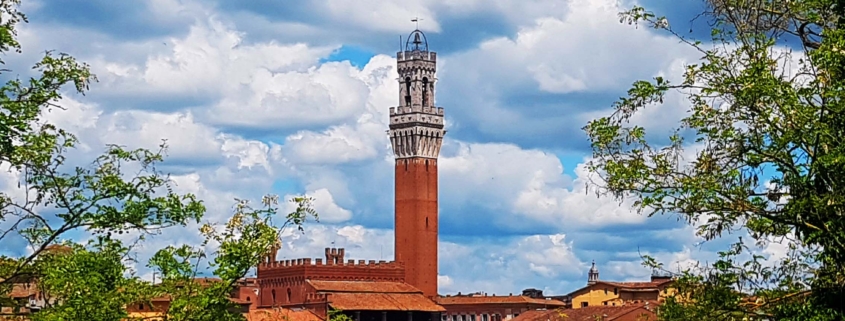private excursion Siena highlights
Page index
Private excursion Siena highlights
Get ready to discover the highlights of Siena with our private excursion from Florence!
We hope that in this article you will find some useful information on how to get a hold of the beautiful heritage of this unique Tuscan city.
Piazza del Campo
Either if you start your visit here or if you leave it for last, you can not miss the very heart of Siena: Piazza del Campo.
In fact, Siena’s main square spreads like an open fan in front of the magnificent Palazzo Pubblico and it gives access to the streets directed to all the different contrade, the city quarters.
For this reason, Piazza del Campo plays a fundamental role in the city’s life and tradition.
Palio di Siena
In particular, it is the arena for the most important event in Siena: the Palio.
The Palio is a unique horserace that opposes 10 jockeys on a horseback, each one representing a contrada.
It is normally held twice a year, on July 2nd and August 16th, respectively for the Feasts of the Madonna di Provenzano and the Madonna Assunta.
It is is an impressive expression of the spirit of competition and simultaneously of aggregation of the different contrade, all distinguished by their colors and symbols.
After a spectacular historical pageant, three laps of a wild bareback horse race around the square decide the winning contrada. Finally, the prize for the winner is the “Palio” which is a painted banner that must include specific iconographic elements, but is always different depending on the style of the author.
Fonte Gaia
Near the center of the square you can see a beautiful a monumental fountain: Fonte Gaia.
A long aqueduct has been carrying water for around 20 kilometers from the Chianti hills to this fountain since the 1300’s.
The sculpted decorative panels nowadays shown in the frame around the basin of the fountain are copies of Jacopo della Quercia’s original ones, which are now exhibited at the Museum of Santa Maria della Scala.
Palazzo Pubblico
The majestic palace that takes up a whole side of Piazza del Campo is the Palazzo Pubblico, also called Palazzo Comunale.
Built between the end of the 1200’s and the following century to become the palace of the government of the city. Still nowadays it is the palace of the municipal administration, but it also houses the civic museum.
Civic museum of Siena
The town hall is a museum in itself, with enchanting frescoes covering the walls of major rooms. These rare examples of secular art from that period have civic and educational intent, rather than religious scenes.
For example, in the famous Allegory of Good and Bad Government, Ambrogio Lorenzetti vividly depicts the opposition between a prosperous city run by the virtues and a ruining one run by the vices.
A notable religious fresco is the Maestà by Simone Martini, depicting the Holy Mary and Child. Inspired by Duccio di Buoninsegna’s Maestà for the Cathedral, Martini’s version is more secular due to the public nature of the building it was in.
Torre del Mangia
The civic tower of Siena, adjacent to the Palazzo Pubblico, is named after il Mangiaguadagni (literally: the Earnings-eater). This was the nickname of Giovanni di Balduccio, the first bell ringer of the tower, probably due to his profligacy or gluttony.
With its 112 meters (367 feet) of height is one of the tallest medieval towers in Italy. It is interesting to know that despite the lower foundations, the altitude of the top is the same of the tower of the Cathedral, symbolizing the equal importance of the two institutions.
Cathedral of Siena
A short walk from Piazza del Campo is Siena’s Cathedral, a must-see destination due to its location on the Via Francigena, which was a major route for pilgrims and travelers.
Built in the 1200s, the Cathedral showcases Siena’s grandeur and can be accessed with tickets purchased at the office or online.
Discover the highlights of Siena with our private excursion from Florence.
Exterior
The external walls of the Cathedral are covered with white marble with lines of dark green marble, named serpentino. They recall the colors of the coat of arms of the city: white and black.
Then, you find yourself in front of the massive façade. An incredible concentration of statues, columns, arches and the generous use of fine polychrome marbles make this front an authentic study model for the romanesque-gothic art.
Interior
The interior of this church is in no way inferior to the outside. The same alternation of white and black marbles is found inside, on the walls and columns. Ceilings, instead, are decorated in blue with golden stars.
Usually between June and October you have the chance to see the most stunning element in the whole structure, right under your feet: the inlaid marble floor.
The level of detail in these representations, made possible by the finest use of different marbles, make this floor unique in the world.
Also, before the altar you can see an extraordinary octagonal pulpit by Nicola Pisano made in Carrara marble.
On the left nave you find the Piccolomini Altarpiece, that features statues by Michelangelo and Pietro Torregiano. A interesting fact about these very two artists is that their rivalry in their youth had gotten to a point where the latter reacted to Michelangelo’s criticisms by punching him and deforming his nose.
Libreria Piccolomini
Always inside the Cathedral, another marvel is represented by the Libreria Piccolomini.
It was originally meant to store the extensive library collection of Pope Pius II, born Enea Silvio Piccolomini. Then, with its gorgeous frescoes by Pinturicchio it became a monument to the life of the above Pope and the art of the Renaissance.
All around the room are exposed precious illuminated choir books from the collection of the Cathedral.
Baptistery
On the other side of the building you find the Baptistery.
In the middle of its beautiful frescoed hall there is the hexagonal baptismal font. In the past it was used to baptize adults before they could go to mass in the church.
It is surrounded by decorative panels made by some of the most famous sculptors, such as Donatello, Lorenzo Ghiberti and Jacopo della Quercia.
Crypt
In 1999 a a hidden underground room was found during some restoration works in the church.
Inside, the restorers found a series of frescoes from the 1200’s in excellent state of conservation.
Built in an earlier phase of the construction of the church, this area was soon filled with construction debris and sealed. For this reason we can still see the original quality of the colors of these ancient wall paintings.
Museo dell’Opera del Duomo
Located on a side of the Cathedral, the Museo dell’Opera del Duomo holds a collection of artwork belonging to the Cathedral.
Rightaway you see the original statues by Giovanni Pisano that were positioned on the façade, as well as the stunning original stained glass of the apsal oculus (the round window) by Duccio di Buoninsegna.
On the first floor you find the Maestà, Duccio di Buoninsegna’s masterpiece, made for the Cathedral’s altar.
From the top floor you have access to the panoramic viewpoint of the Facciatone, the unfinished facade of the “Duomo Nuovo”. In fact, in the 1300’s the general layout Cathedral was going to change, but the black plague of 1348 and the enormous costs of the project caused the interruption of the works.
Santa Maria della Scala
Also at the same ticket office you can get the pass to visit the museum of Santa Maria della Scala.
The Ospedale was built in the 1200’s to host and give medical attention to the pilgrims and the poor and to nurture orphans and abandoned children.
Via di Città e Piazza Salimbeni
Piazza salimbeni is a small square in the center of the city. It is renowned for hosting, today as then, the offices of the first bank in Europe, called Monte dei Paschi di Siena, founded in 1472.
You can admire the buildings with Renaissance architecture; the statue of Sallustio Bandini, an economist priest; and several busts of important figures on the frame of the roof of the building on the right, including Dante Alighieri.
San Domenico
The basilica of San Domenico is one of the most important churches in the city. It is an imposing red brick building, dating back to the 13th century, with a typically Gothic appearance. This church, in addition to works of extraordinary workmanship, preserves the remains of Santa Caterina who lived nearby.
How to book your private excursion to Siena and discover the highlights?
Siena, after Florence, is the most important city in Tuscany from an artistic and landscape point of view.
You can choose whether to visit it together with other areas, such as Chianti or San Gimignano, or spend the whole day here.
Click here to find out about our classic tour proposal, or customize your experience by contacting us here.
Get ready to discover the highlights of Siena with our private excursion from Florence!






 tuscanyexcursions.com
tuscanyexcursions.com
